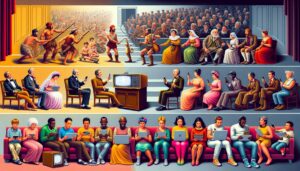The Future Sound of Music: How Streaming Services Are Reshaping the Industry

Waving goodbye to the days of stashing CDs and cassettes, we stand amidst a revolution: The Digital Music Revolution. Like a digital wave washing over an analog beach, streaming services such as Spotify, Apple Music, and Tidal have fundamentally reshaped how audiences discover, access, and connect with music. This sea change heralds the dawn of a new era, one marked by limitless libraries, personalized playlists, and a global platform for emerging artists.

Today, your favorite entertainment song is just a click away, devoid of any chasms caused by geographical boundaries or gaps in physical distribution. This has immensely impacted not just music consumption, but the structure of the industry, artist revenues, and the artistry of music itself.
To understand the shift, consider the pre-digital age. Following a hit-or-miss strategy, record labels would painstakingly produce physical albums, set up distribution channels, and invest heavily in promotion, relying solely on radio plays and store purchases. Now, streaming services have democratised music consumption by putting a world’s worth of music in consumers’ pockets. The populist approach of these platforms has shaken the hierarchical music industry to its core, democratizing the music space and creating a global pallet for artists and creators.
From an artist perspective, the change is multi-dimensional. Streaming platforms have brought a shift from album-focused to single-focused production. Here the success of a single track can boost an artist’s visibility. Unfortunately, this democratisation also means increased competition.
While some artists still manage to strike gold, the shift to track-based consumption and the sheer quantum of music have given rise to a ‘winner takes all’ market. However, emerging artists have found a silver lining in the reach provided by these platforms, wherein a well-crafted single can snowball into viral fame.
Furthermore, the advent of playlists has revolutionized music discovery. Streaming services use complex algorithms to learn users’ tastes and then curate organic playlists. This has led to the rise of mood-based listening, a factor exploited by marketers using ‘mood marketing’.
Despite these seismic shifts, the music industry still wrestles with a fundamental challenge: artist remuneration. Streaming services have been criticized for their micro-payment models despite their skyrocketing revenue. This has initiated discussions about the need for fairer payment structures within the streaming ecosystem.
Projecting into the future, we can expect the music industry to become more immersive and experiential. Think virtual concerts by your favorite artists from the comfort of your homes, powered by VR and AR technologies, or AI crafting personalized songs based on your tastes. Indeed, the decibels of change are only set to rise.
As we navigate the challenges and embrace the opportunities the digital age presents, the future of music is less about streaming and more about a cultural shift. A shift towards personalization, accessibility, and an equitable distribution scheme.
With the democratization of music, we, the listeners, hold more power than ever before. And with this power comes the responsibility to champion the artists we love and believe in. After all, amidst the codes and algorithms, at its heart, music remains an exploration of human emotion and expression. It’s up to us to ensure that exploration continues resonating across the digital sound waves.






